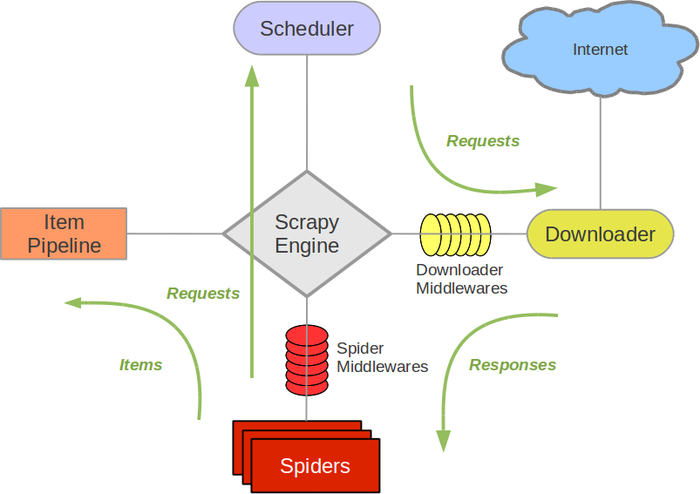Scrapy 框架
-
Scrapy是用纯Python实现一个为了爬取网站数据、提取结构性数据而编写的应用框架,用途非常广泛。
-
框架的力量,用户只需要定制开发几个模块就可以轻松的实现一个爬虫,用来抓取网页内容以及各种图片,非常之方便。
-
Scrapy 使用了 Twisted
['twɪstɪd](其主要对手是Tornado)异步网络框架来处理网络通讯,可以加快我们的下载速度,不用自己去实现异步框架,并且包含了各种中间件接口,可以灵活的完成各种需求。
Scrapy架构图(绿线是数据流向):

-
Scrapy Engine(引擎): 负责Spider、ItemPipeline、Downloader、Scheduler中间的通讯,信号、数据传递等。 -
Scheduler(调度器): 它负责接受引擎发送过来的Request请求,并按照一定的方式进行整理排列,入队,当引擎需要时,交还给引擎。 -
Downloader(下载器):负责下载Scrapy Engine(引擎)发送的所有Requests请求,并将其获取到的Responses交还给Scrapy Engine(引擎),由引擎交给Spider来处理, -
Spider(爬虫):它负责处理所有Responses,从中分析提取数据,获取Item字段需要的数据,并将需要跟进的URL提交给引擎,再次进入Scheduler(调度器), -
Item Pipeline(管道):它负责处理Spider中获取到的Item,并进行进行后期处理(详细分析、过滤、存储等)的地方. -
Downloader Middlewares(下载中间件):你可以当作是一个可以自定义扩展下载功能的组件。 -
Spider Middlewares(Spider中间件):你可以理解为是一个可以自定扩展和操作引擎和Spider中间通信的功能组件(比如进入Spider的Responses;和从Spider出去的Requests)
制作 Scrapy 爬虫 一共需要4步:
- 新建项目 (scrapy startproject xxx):新建一个新的爬虫项目
- 明确目标 (编写items.py):明确你想要抓取的目标
- 制作爬虫 (spiders/xxspider.py):制作爬虫开始爬取网页
- 存储内容 (pipelines.py):设计管道存储爬取内容
Scrapy的安装介绍
1.windows下安装
a.pip3 install wheel b.pip3 install lxml-3.7.3-cp35-cp35m-win_amd64.whl c.pip3 install Twisted-17.1.0-cp35-cp35m-win_amd64.whl d.安装pywin32 e.pip3 install Scrapy
2.ubuntu下安装
a.sudo apt-get install python3 python3-dev python-pip libxml2-dev libxslt1-dev zlib1g-dev libffi-dev libssl-dev b.安装pip3 sudo apt-get install python3-pip 更新pip3 sudo pip3 --default-timeout=100 install –upgrade pip c.安装scrapy sudo pip3 --default-timeout=100 install scrapy 验证安装是否成功 scrapy
一. 新建项目(scrapy startproject)
- 在开始爬取之前,必须创建一个新的Scrapy项目。进入自定义的项目目录中,运行下列命令:
scrapy startproject mySpider
制作爬虫 (spiders/itcastSpider.py)
爬虫功能要分两步:
1. 爬数据
- 在当前目录下输入命令,将在
mySpider/spider目录下创建一个名为itcast的爬虫,并指定爬取域的范围:
scrapy genspider itcast "itcast.cn"
要建立一个Spider, 你必须用scrapy.Spider类创建一个子类,并确定了三个强制的属性 和 一个方法。
-
name = "":这个爬虫的识别名称,必须是唯一的,在不同的爬虫必须定义不同的名字。 -
allow_domains = []是搜索的域名范围,也就是爬虫的约束区域,规定爬虫只爬取这个域名下的网页,不存在的URL会被忽略。 -
start_urls = ():爬取的URL元祖/列表。爬虫从这里开始抓取数据,所以,第一次下载的数据将会从这些urls开始。其他子URL将会从这些起始URL中继承性生成。 -
parse(self, response):解析的方法,每个初始URL完成下载后将被调用,调用的时候传入从每一个URL传回的Response对象来作为唯一参数,主要作用如下:- 负责解析返回的网页数据(response.body),提取结构化数据(生成item)
- 生成需要下一页的URL请求。
然后运行一下看看,在mySpider目录下执行:
scrapy crawl itcast
是的,就是 itcast,看上面代码,它是 ItcastSpider 类的 name 属性,也就是使用 scrapy genspider命令的唯一爬虫名。
代码部分:
pipelines.py
# -*- coding: utf-8 -*- import json class ItcastPipeline(object): # __init__方法是可选的,做为类的初始化方法 def __init__(self): # 创建了一个文件 self.filename=open('myteacher.json','w') # process_item方法是必须写的,用来处理item数据 def process_item(self,item,spider): test_content=json.dumps(dict(item),ensure_ascii=False)+"\n" self.filename.write(test_content.encode('utf-8')) # close_spider方法是可选的,结束时调用这个方法 def close_spider(self,spider): self.filename.close()
items.py
# -*- coding: utf-8 -*-
import scrapy class ItcastItem(scrapy.Item): name=scrapy.Field() title=scrapy.Field() info=scrapy.Field()
爬虫文件
itcastspider.py
import scrapy from mySpider.items import ItcastItem class ItcastSpider(scrapy.Spider): name="itcast" allowd_domains=["http://www.itcast.cn/"] start_urls=[ "http://www.itcast.cn/channel/teacher.shtml#aandroid", "http://www.itcast.cn/channel/teacher.shtml#ac", "http://www.itcast.cn/channel/teacher.shtml#acloud", "http://www.itcast.cn/channel/teacher.shtml#aios", "http://www.itcast.cn/channel/teacher.shtml#ajavaee", "http://www.itcast.cn/channel/teacher.shtml#anetmarket", "http://www.itcast.cn/channel/teacher.shtml#aphp", "http://www.itcast.cn/channel/teacher.shtml#apython", "http://www.itcast.cn/channel/teacher.shtml#astack", "http://www.itcast.cn/channel/teacher.shtml#aui", "http://www.itcast.cn/channel/teacher.shtml#aweb" ] def parse(self,response): items=[] teacher_list=response.xpath('//div[@class="li_txt"]') for content in teacher_list: name=content.xpath('./h3/text()').extract() title=content.xpath('./h4/text()').extract() info=content.xpath('./p/text()').extract() item = ItcastItem() item['name']=name[0] item['title']=title[0] item['info']=info[0] # items.append(item) yield item # return items
保存数据
scrapy保存信息的最简单的方法主要有四种,-o 输出指定格式的文件,,命令如下:
# json格式,默认为Unicode编码 scrapy crawl itcast -o teachers.json # json lines格式,默认为Unicode编码 scrapy crawl itcast -o teachers.jsonl # csv 逗号表达式,可用Excel打开 scrapy crawl itcast -o teachers.csv # xml格式 scrapy crawl itcast -o teachers.xml
pipelines.py
# -*- coding: utf-8 -*- import json class TencentPipeline(object): def __init__(self): self.fileName=open('job.json','w') def process_item(self, item, spider): text=json.dumps(dict(item),ensure_ascii=False)+"\n" self.fileName.write(text.encode('utf-8')) return item def close_spider(self,spider): self.fileName.close()
items.py
import scrapy class TencentItem(scrapy.Item): positionName = scrapy.Field() positionLink = scrapy.Field() positionTpye = scrapy.Field() peopleNum = scrapy.Field() workLocation = scrapy.Field() publishTime = scrapy.Field()
tencentspider.py
# -*- coding: utf-8 -*- import scrapy from tencent.items import TencentItem class TencentspiderSpider(scrapy.Spider): name = 'tencent' allowed_domains = ['tencent.com'] offset=0 url = "http://hr.tencent.com/position.php?&start=" start_urls = [url+str(offset)] def parse(self, response): root_list=response.xpath('//tr[@class="even"] | tr[@class="odd"]') for content in root_list: item=TencentItem() item['positionName'] =content.xpath('./td[1]/a/text()').extract()[0] item['positionLink'] =content.xpath('./td[1]/a/@href').extract()[0] item['positionTpye'] =content.xpath('./td[2]/text()').extract()[0] item['peopleNum'] =content.xpath('./td[3]/text()').extract()[0] item['workLocation'] =content.xpath('./td[4]/text()').extract()[0] item['publishTime'] =content.xpath('./td[5]/text()').extract()[0] yield item if self.offset<600: self.offset+=10 yield scrapy.Request(self.url+str(self.offset),callable=self.parse)
爬取斗鱼图片
settings.py
# -*- coding: utf-8 -*- ITEM_PIPELINES = { 'douyu.pipelines.ImagesPipeline': 300, } IMAGES_STORE = "/Users/Power/lesson_python/1103/day04/douyu/Images"
items.py
# -*- coding: utf-8 -*- import scrapy class DouyuItem(scrapy.Item):
nickname = scrapy.Field()
imagelink = scrapy.Field()
imagePath = scrapy.Field()
#pass
pipelines.py
# -*- coding: utf-8 -*-
import scrapy
from scrapy.utils.project import get_project_settings
from scrapy.pipelines.images import ImagesPipeline
import os
class ImagesPipeline(ImagesPipeline):
#def process_item(self, item, spider):
# return item
# 获取settings文件里设置的变量值
IMAGES_STORE = get_project_settings().get("IMAGES_STORE")
def get_media_requests(self, item, info):
image_url = item["imagelink"]
yield scrapy.Request(image_url)
def item_completed(self, result, item, info):
image_path = [x["path"] for ok, x in result if ok]
os.rename(self.IMAGES_STORE + "/" + image_path[0], self.IMAGES_STORE + "/" + item["nickname"] + ".jpg")
item["imagePath"] = self.IMAGES_STORE + "/" + item["nickname"]
return item
douyumeinv.py
# -*- coding: utf-8 -*-
import scrapy
from douyu.items import DouyuItem
import json
class DouyumeinvSpider(scrapy.Spider):
name = "douyumeinv"
allowed_domains = ["capi.douyucdn.cn"]
offset = 0
url = "http://capi.douyucdn.cn/api/v1/getVerticalRoom?limit=20&offset="
start_urls = [url + str(offset)]
def parse(self, response):
# 把json格式的数据转换为python格式,data段是列表
data = json.loads(response.text)["data"]
for each in data:
item = DouyuItem()
item["nickname"] = each["nickname"]
item["imagelink"] = each["vertical_src"]
yield item
self.offset += 20
yield scrapy.Request(self.url + str(self.offset), callback = self.parse)


